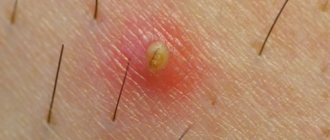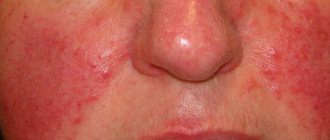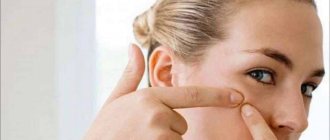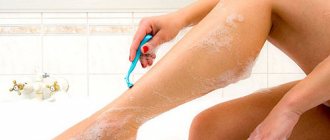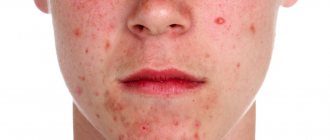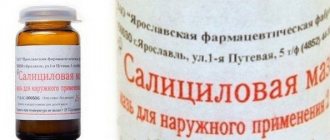Pimples on the anus are a delicate problem that affects many people. They arise for various reasons. Some types are painless (for example: polyps), but at the same time dangerous because they can develop into an oncological tumor.
Other types of acne cause pain and discomfort (boils), but they can be treated successfully and in rare cases cause complications. If acne appears, contact a proctologist and get examined.
What types of acne are there?
There are several types of pimples that appear near the anus. They may have a viral nature or rashes appear as a result of the inflammatory process.
Some types of acne appear for reasons that have not yet been clarified in coloproctology.
Boils
These are large purulent pimples that look like dense protrusions filled with pus. They appear in different places, including on the sphincter.
They cause severe pain to the patient. Boils limit a person’s movement because they hurt a lot. They are opened in a hospital, surgically under local anesthesia. The cavity filled with pus is cleaned. The patient is prescribed a course of antibiotics. If the boil is small, then traditional therapy is possible.
Boils form when hair follicles become infected. This happens quite often, because with minor trauma to the anus, fecal matter and other bacteria can get into the microcrack. This causes an inflammatory process and a boil appears near the anus.
Polyps
These are large and painless pimples located near the anus. Outwardly, they look like a large eel, the color is red or bluish. Despite their apparent harmlessness, polyps should be removed surgically. Over time, they grow and begin to bleed. Subsequently they develop into cancer.
Polyps appear as a result of frequent constipation or diarrhea, poor nutrition with a predominance of harmful foods, and intestinal pathologies. They are often hereditary. Polyps can be single or multiple, sometimes they form diffuse clusters (affect large areas of the intestine).
There are several types of formations:
- fibrous - formed from connective tissues, in extremely rare cases they degenerate into oncology;
- villous - look like many papillae, often bleed;
- hyperplastic - polyps that rarely become malignant, their size is up to 5 millimeters;
- adenomatous - polyps indicating a precancerous condition;
- mixed - combining different types of polyps.
Polyps are similar to hemorrhoids and can be easily confused. A coloproctologist can determine the nature of a pimple by examining the results of a coloscopy.
Cyst
It is a benign tumor that can be located near the anus. Inside the cyst there is a soft substance, sometimes there are hairs in it. This is a safe tumor, but it will have to be removed surgically.
It grows extremely slowly, in the first stages it looks like an ordinary pimple. Periodically, the cyst becomes inflamed. At the final stages of development, the cyst grows to the size of a pea or even an apricot.
Genital herpes
This is a sexually transmitted disease caused by the herpes virus. Transmitted sexually. The first symptoms appear a week after infection. If the disease is not treated, it becomes chronic. It is characterized by the appearance of acne in the genital area and around the anus.
Pimples look like ulcers, over time they burst, and dry crusts appear in their place. If the wound gets infected again, it does not heal for a long time and can become filled with serous-purulent contents.
Perirectal fistula
A pimple with a rod inside, from which pus periodically flows. A fistula connects the source of infection to the skin; it usually appears as a result of an acute form of paraproctitis.
Anal warts
Located in the anus. They can be of different types: pointed papillomas (these are elongated papillae, similar to a cauliflower inflorescence or a cockscomb), flat warts, elongated papules (they look like a finger), huge condylomas (they were named after Buschke-Lowenstein, they can completely block the anus).
All warts have a pink color and a surface similar to many papillae. They appear as a result of infection with the papilloma virus, after sexual contact with a carrier of the infection. Warts are often found in men who prefer homosexual relationships.
Malignant tumors
At the first stages of development, they look like ordinary acne. Over time they begin to grow in size. When malignant neoplasms are detected in the initial stages, the treatment prognosis is positive in most cases.
Treatment of anal irritation in a child
Redness around the anus in a child is a fairly common problem, which in the vast majority of cases is explained by violations of basic hygiene and improper care of delicate children's skin. However, such a nuisance can also signal the development of certain pathological processes and reactions, in particular:
- Allergic reactions of various types.
- Helminthic infestations.
- Disturbances in the gastrointestinal tract, including dysbiosis, diarrhea, irritable bowel syndrome (IBS), etc.
- Fungal diseases.
At different ages
Doctors say that the causes of irritation and redness at different ages in children most often differ:
- In infants, severe redness is usually the result of insufficient proper care. Somewhat less often, unpleasant symptoms occur due to taking medications, poor nutrition and allergies. Sometimes the culprit of redness is a fungal infection - candidiasis.
- In children from one to three years old, a red bottom is most often caused by insufficient hygiene, because children at this age are still learning to use the potty correctly and their underwear can become dirty, irritating the delicate skin of the anus and buttocks. In second place among the possible causes is dysbacteriosis, disturbances in the gastrointestinal tract and allergic reactions. The development of parasitic diseases - helminthic infestations is possible.
- In children 3–5 years old who actively attend kindergarten, the butt may turn red due to insufficient hygiene, because children do not yet know how to wipe it well. Also, very often the culprits of redness are worms, which are easily transmitted from child to child in children's groups. If a child is often sick and regularly takes antibiotics, redness is most likely a consequence of dysbiosis.
Since the baby, as a rule, at this time is too small to tell you about his illness, mothers and grandmothers have to notice everything themselves and check with the doctor (if necessary) what needs to be done. But before prescribing treatment, any doctor will first identify the cause, and there may be several of them:
- Not the most expected thing for parents, but quite likely it is enterobiasis (helminthiasis, pinworm infection). This is evidenced by a poor night's sleep (the reason here lies in the increasing itching and severe irritation of the child's anus), as well as more frequent bowel movements and pain when palpating the right side of the abdomen. Only a doctor can make such a diagnosis!
- Severe irritation around the anus in a child may be the result of an allergy to underwear, diapers, or cosmetics. By removing or replacing products, you can remove the allergen, and at the same time, redness and irritation will go away. In this case, itching and peeling of the skin are also possible, so again, your local pediatrician or dermatologist can diagnose this cause.
- With prolonged poisoning, diarrhea and a complex infection, irritation around the child’s anus may also occur. In this case, it will be necessary to remove the cause and then the consequences in the form of irritation.
- Do not exclude the fact that the anus is reddened as a result of more complex diseases. For example, colitis, it affects the intestinal mucosa and can ultimately manifest itself in the form of irritation of the child’s anus. Thus, frequent bowel movements, abdominal pain, decreased appetite, and blood in the stool should alert you. You urgently need the help of a doctor to confirm the final diagnosis and prescribe quality treatment. In this case, for example, with paraproctitis, in addition to a local increase in temperature at the site of irritation of the anus, there will also be swelling. In general, we want to protect you from illiterate diagnoses and self-medication. If you realize that you are no longer in control of the situation, consult a doctor; if you understand that even when palpated, the baby reacts sharply to the stomach - call an ambulance!
We invite you to read: How many procedures do you need to do to get the effect of facial peeling?
We do a full course of peeling: how many sessions are required, the frequency of them. Treatment of irritation or, in medicine, the term perianal dermatitis is usually used, follows after an accurate diagnosis.
The first step in such irritation is to rule out pinworm infection. If after all the tests they are not detected, then this is good. But! As soon as the doctor suspects enterobiasis, it is wise for him to prescribe treatment for all family members according to the schedule; take a course of pills now, in two and four weeks, respectively. In this case, it is important to treat each family member to avoid recurrent diseases.
Dietary nutrition and the necessary course of medications are prescribed when diagnosing inflammation of the gastrointestinal tract. Try to describe the situation to your doctor in as much detail as possible so that, together with the tests performed, a treatment with a simple and effective schedule can be drawn up. Thus, over time, the irritation of the child’s anus will go away quite quickly.
In case of infection of the mucous membrane and area around the anus of a child with bacterial microflora, a set of measures must be carried out using antiseptics. They are used until all visible irritation goes away and the normal functioning of the child’s body returns to normal.
Fungicidal ointments are used if the anus area is infected with a fungal infection. But a doctor will be able to make a diagnosis, as well as prescribe treatment.
Acne in children
Delicate baby skin reacts to any irritants, especially the skin of the perineum, anus and genitals.
In rare cases, children develop the same acne as adults (warts or polyps). But most often, a child develops pimples as a result of prickly heat or diaper dermatitis. In both cases, they present as a red rash that itches.
Such rashes appear as a result of insufficient hygiene, infrequent washing of the baby, untimely changing of diapers, and prolonged skin contact with a wet diaper or diaper.
Miliaria also occurs in adults who are overweight. It appears especially often during the hot season.
How to treat acne
Therapy depends on the reasons that caused the pimple to appear. Treatment is individual in each specific case.
- Warts and condylomas are removed surgically using local anesthesia. Surgeons burn them out with a laser or radio wave beam. After the operation, the patient is prescribed a course of immunomodulators and a vitamin-mineral complex.
- Polyps must be removed surgically. They can develop into a malignant neoplasm, so they cannot be ignored.
- A dermoid cyst is similar to a pimple; the cause of its occurrence is still unclear. Treatment involves surgical excision of the cyst, then the wound is sutured and drainage is installed.
- Large boils are opened by surgeons, and the cavities are cleared of pus. The patient then takes antibiotics to prevent the infection from spreading. If the boil is small in size, then it is treated using traditional methods. Pimples are treated with antiseptics and compresses are made from ointments (Vishnevsky or Levomekol).
- Genital herpes is treated by a venereologist, since it is a sexually transmitted disease. Therapy is carried out using antiviral drugs (Acyclovir, Famciclovir, Lizavir). In parallel, immunomodulators are prescribed.
- If you have heat rash or diaper dermatitis, you should maintain personal hygiene and regularly wash your anus and genitals. Treat the rash with drying agents.
During treatment, follow a strict diet (exclude fried, fatty foods and foods containing yeast).
Subcutaneous formations
If there is the appearance of acne with a dense structure that looks like watery formations, this may indicate the development of papillomas. In this case, a person may be infected with HPV or have reduced protective properties of the body, lacking vitamins and minerals in the body.
When pimples with watery contents form, which often burst, they speak of the development of a herpes infection. During this period, the woman is a source of infection, which can easily be transmitted to her sexual partner.
Pimples inside the vagina, which look like tubercles, do not cause discomfort and are easily palpable, can develop for the following reasons:
- The development of wen as a result of blockage of the sebaceous glands. This phenomenon is not dangerous to health; in severe cases, surgery may be required.
- Disorder of the functionality of the sebaceous glands. In this case, the formations may change in size, but do not cause discomfort. They do not pose a threat to health and are an individual feature of a woman’s body.
- Immune system disorders, autoimmune diseases. This pathology requires treatment. With such disorders, the pimples on the vaginal lips will hurt.
We suggest you familiarize yourself with acne and pimples on the back causes
Molluscum contagiosum appears in the form of a dense small nodule. This pathology develops with weakened immunity, the presence of arthritis, and also in those who are prone to allergic reactions. The formation disappears spontaneously, but can be observed within two years.
Cysts of the Bartholin glands, which are located in the vagina, may also be observed. When the glands become blocked, benign growths develop that do not cause pain. They usually do not require therapy. But when infected, they become inflamed and filled with purulent contents, and therefore require treatment with antibacterial drugs.
Reviews
Valeria, 22 years old:
My nephew developed pimples on his labia, near his anus. The pediatrician said it was heat rash. My sister and I now wash it several times a day and treat it with a drying antiseptic powder.
I got infected with genital herpes, at first I didn’t understand what happened. I see one pimple appeared, and then dozens. They began to peel off and new ones appeared in their place. I went to the venereologist and found out about the diagnosis, now I am being treated with antiviral drugs.
Conclusion
Doctors warn! Shocking statistics - it has been established that more than 74% of skin diseases are a sign of parasite infection (Accarida, Giardia, Toxocara). Worms cause enormous harm to the body, and the first to suffer is our immune system, which should protect the body from various diseases. The head of the Institute of Parasitology shared the secret of how to quickly get rid of them and cleanse your skin, it turns out that’s enough. Read more .
Hygiene features
Poor hygiene is the most common cause of redness of the butt in children of all ages. Therefore, it is important for parents to know the basic rules for caring for babies of different ages:
- Babies wearing diapers should be washed with plain water without soap every time the diaper is changed. Detergents should be used only according to age and no more than once a day (so as not to dry out delicate skin). It is possible to use various drying agents for infants - powder, creams and ointments for diapers, but formulations that are too greasy can aggravate the problem of redness. It is also very important to give your baby regular air baths and not to wrap him up excessively.
- For young children (up to three years old), it is advisable to wash their bottom with plain clean water after going to the toilet. If this is not possible, you need to use wet wipes. The child must get used to a daily bath or shower and use his own individual towel.
- Children of kindergarten age should already be learning to wipe their butts on their own using the same wet wipes. But adults need to control this process, because even small particles of feces can cause severe inflammation and redness. Daily water procedures remain familiar.
We invite you to familiarize yourself with Removal of age spots on the face with laser, mesotherapy, salon peeling
Causes
Do not be alarmed ahead of time when you see a pimple near the anus or a collection of them on the perineum. Often, the reasons for the formation of wen in intimate places are similar to the reasons for their appearance throughout the body. Looking at photos of various rashes, one can guess about the nature of the pimple.
Well-known factors that cause skin problems in the anal area include:
- Genetic predisposition. A person can devote a lot of time to caring for his body, use expensive intimate gels, do hair removal in a timely manner, but he will still be visited by acne on the perineum. It is necessary to carefully monitor the condition of the intimate organs and the skin around the anus.
- Increased physical activity. Exercising in tight leggings or sweatpants promotes increased sweat formation, preventing heat transfer. As a result, the skin near the anus overheats, which provokes irritation and the occurrence of acne.
- Androgens. In men, sex hormones contribute to the formation of acne on the face, chin, back and perineum. The accumulation of sebum leads to clogged pores, which in turn causes unsightly, itchy acne. In women, acne formation increases before menstruation.
- Allergic reactions. They can arise from anything: synthetic underwear, washing powders, the use of latex condoms. Even prolonged exposure to the sun, especially for a nudist, leads to the formation of itchy pimples in the anal area.
Allergic rashes
Unfortunately, the problem of acne in intimate places and the anus may not be as harmless as it appears at first glance. Compliance with hygiene measures using anti-inflammatory drugs is not always effective when it comes to serious diseases. White pimples may indicate the presence of the herpes virus in the body. Primary syphilis is characterized by the appearance of so-called roseola or chancre. The rash becomes white as the disease progresses, most often on the neck (leucoderma or “Venus necklace”). With chickenpox, blisters spread throughout the body, sometimes forming on the anus.
Localization of rashes on the female genital organs
Most often, acne appears on the labia majora.
- This place is most exposed to external influences and injury, for example, from underwear or a razor. The presence of hair also often leads to blockage of the sebaceous gland ducts and inflammation.
- A common place for acne to occur is the vagina and its opening. This is where the skin is most sensitive and for various reasons it can be exposed to bacteria or viruses.
- Pimples near the anus appear due to poor personal hygiene. And if the rash covers the entire mucous membrane of the genital organs, this is a clear sign of an infectious disease.
Genital herpes
The herpes simplex virus is divided into two types, different in their characteristics:
- First type. Most often it appears on the lips and is the cause of colds. If personal hygiene rules are not followed, virus particles are transferred to other parts of the body: eyelids, under nails, groin, mouth. A pimple near the anus may appear as a result of scratching the intimate organs with dirty hands after touching the lips.
- Second type. Characterized by rashes in the genital area, on the perineum, and in the anus. The skin lesions sometimes affect the buttocks, thighs and lower back.
Genetic herpes
Genital herpes is a chronic disease. Once in the body, it lives there until the end of the patient’s life, and recurs from time to time. A person remains infectious to others even during remission. To prevent the disease, it is worth maintaining personal hygiene and avoiding casual sexual intercourse, since infection with the virus mainly occurs during sexual contact. A small pimple on the anus can lead to serious inflammation. There is currently no effective therapy, so it is easier to prevent the disease than to fight it all your life.
Genetic herpes in women
Women suffering from genital herpes are at risk of developing associated complications. Sexual intercourse becomes difficult due to the pain that acne creates near the genitals. Since the vagina and cervix are affected, the woman faces decreased reproductive function. When the virus enters the body, a person feels fever, nausea, weakness, and swollen lymph nodes. Without special therapy that prevents the activity of the virus, acne appears in the anus, near the external genitalia, and on the walls of the vagina in women.
Red pimples
If there are small pimples on the vagina that do not cause pain, this may indicate acne. When pain and inflammation appear, we can talk about the following pathologies:
- disruption of the hormonal or endocrine system;
- emotional stress, lack of sleep;
- a nervous system disorder that causes red bumps to appear in the vagina.
We invite you to familiarize yourself with clear liquid coming out of a pimple.
Red formations with a white coating indicate candidiasis, which is accompanied by a viral infection. Candidiasis itself does not cause pain; with this pathology, white discharge and itching appear. The reason for this phenomenon may be prolonged stress, uncontrolled use of antibacterial drugs, and a decrease in the body’s protective properties.
If red, dark, round formations appear in the vagina and anus, you should immediately consult a doctor. This is how secondary syphilis can manifest itself. In this case, there is no pain or discomfort; peeling of the skin may begin. In some cases, acne disappears on its own without forming scars.
Pimples can appear as a result of lice pubis, which is caused by pubic lice. In addition to rashes, a woman may experience itching, burning, and discomfort.
Treatment methods
It is advisable to use topical medications only after consulting a doctor. Even in an adult, the skin in the perineal and anal area is very delicate, so irritating ointments or gels can have a negative effect on the pimple near the anus. It is allowed to wipe the inflamed area with a weak solution of potassium permanganate or furatsilin. It is appropriate to use streptocidal ointment, which is suitable even for children.
During the treatment period it is necessary:
- avoid warm, tight-fitting trousers;
- wear loose underwear made of natural fabric;
- carefully monitor intimate hygiene;
- avoid stress and hypothermia;
- touch the skin near the anus as little as possible and only with clean hands;
- abstain from sexual intercourse.
Regular acne near the anus, if you follow the doctor's recommendations, goes away quickly. If the disease is viral in nature, it is necessary to fight the pathogen. Most sexually transmitted infections are difficult to treat, and some of them remain in the host’s body forever.
Medicinal methods for treating acne on the anus:
- Therapy in case of infection with genital herpes is aimed at reducing the activity of the pathogen and increasing immunity. It is impossible to completely get rid of the virus. A well-known drug in the treatment of herpes is Acyclovir.
- If acne on the anus is of allergic origin, it is recommended to take antihistamines. There are many antiallergy medications that are sold without a prescription.
- For swelling and pain, it is appropriate to use non-steroidal anti-inflammatory drugs (analgin, aspirin, Ibuprofen, etc.).
Local preparations
Laboratory diagnosis is based on a general blood test and special studies that can determine the presence of the genital herpes virus. To influence the external symptoms of the disease, you need to find out why a pimple appeared in the anus or perineum. A general examination and collection of a detailed medical history will help the doctor with a diagnosis in order to begin treatment of the disease as quickly as possible.
Perianal dermatitis is manifested by an inflammatory process in the anal area and is accompanied by hyperemia, swelling and painful itching.
This form of the disease can have an allergic, contact, fungal and bacterial development. The most common provoking factors are cracks in the anus, inflammation, hemorrhoids, enterobiasis and dysbacteriosis. The main importance in diagnosis is the analysis of perianal scraping followed by symptomatic treatment.
This form of dermatitis can appear in patients of different ages and genders. In newborns, symptoms are often associated with poor hygiene; in adult patients, perianal dermatitis can develop as a result of pathological processes in the large intestine and rectum.
Diagnosis and symptomatic treatment
The diagnostic complex and treatment are prescribed strictly by the doctor, depending on the nature of the disease and the degree of neglect. First, the proctologist performs an examination. If the problem is a boil or acne, the doctor opens it and sanitizes it.
After removing the formation itself and extracting the tissue for laboratory analysis, these fragments are sent for research. This is carried out in many cases in addition to other instrumental studies.
! Most often, the appendage in the intestine is a hemorrhoidal node of the rectum and inflammation of the venous vessels. To get a better idea of his condition, the doctor performs palpation, and the patient is sent for instrumental diagnostics.
Small pimple-like bodies usually do not cause any discomfort; discomfort can only appear when applying a personal hygiene routine. If it is painful, then inflammation has already begun.
Doing it on your own in such cases is dangerous and can lead to extremely complex consequences. In conditions of self-medication and traditional medicine, people take analgesics and painkillers. When your anus itches, you need to urgently make an appointment with a doctor.
In most cases, in the treatment of problems in both men and women, innovative techniques are used - they are a priority for tumors that are not associated with oncology. The method of pain relief is chosen by the physician personally for the patient.
During the period of use of the treatment complex, you should avoid alcohol, follow a medical diet, and try to have a bowel movement every day. For hemorrhoids, vein tonics and analgin are used to relieve pain.
Causes of the disease
In newborn babies, the symptoms of the inflammatory process in the perianal folds are similar to the picture of diaper dermatitis, which develops from contact with diapers, dirty clothes, or accidental injury to the delicate skin of the baby's anus.
Symptoms of perianal dermatitis are provoked by the following factors:
- prolapse of hemorrhoids;
- dysbacteriosis;
- underwear made of synthetic fabrics;
- enterobiasis;
- anal fissures followed by scratching;
- intestinal diseases (proctitis, colitis, paraproctitis, etc.);
- mechanical damage to the anal area contributes to secondary infection, which can result in fungal dermatosis;
- “Drivers syndrome” is an abscessing form of fistulous perianal inflammatory process, which is observed during prolonged driving in a vehicle or on a horse.
Patients with an allergic predisposition often suffer from perianal dermatitis, since a decrease in immune forces with simultaneous inhibition of tissue barrier functions contributes to easier penetration of infection. Similar symptoms may be present in infants, HIV-infected people and the elderly.
General symptoms of the disease
The perianal form of dermatitis has characteristic symptoms:
- the appearance of unbearable itching in the anus;
- the inflamed area is swollen, hyperemic and slightly thickened (pictured);
- a watery rash may appear;
- Hemorrhoids may cause pain;
- erosive ulcerations, which subsequently become covered with a crust.
If perianal dermatitis occurs for a long time, then the buttocks may be involved in the inflammation process. In this case, there is a sharp reddening of the skin with ulcerations, as well as a deterioration in the general condition of the patient.
Symptoms according to the forms of perianal dermatitis:
In the ALLERGIC FORM of perianal dermatitis, symptoms are expressed by the appearance of bubbles with transparent contents and severe itching (pictured). As a rule, negative symptoms disappear as allergens are eliminated.
With FUNGAL DEVELOPMENT of perianal dermatitis, redness in the perineal area and peeling of the skin at the site of the lesion are observed. The inflammatory focus has clear, uneven shapes, which can be covered with a white coating (pictured) and a fine-bubble rash.
BACTERIAL DEVELOPMENT is accompanied by unbearable itching, hyperemia of the skin at the site of inflammation, up to erosive formations (pictured). Purulent blisters can open on their own, followed by the formation of crusts. In some cases, increased body temperature is possible.
“JEEP DISEASE” is characterized by the spread of multiple purulent blisters that can burst open on their own. As a rule, this leaves an ulcerative surface that does not heal for a long time. Complications of this form of the disease include the appearance of fistula tracts, which requires mandatory surgical intervention.
Diagnostics
A diagnostic examination begins with collecting the necessary medical history, taking into account the symptoms of the disease and the patient’s complaints. In addition, the laboratory response to dysbiosis and fungal microflora is assessed.
The doctor may prescribe a number of necessary examinations for the patient, which include:
- performing ultrasound;
- radiography;
- coprogram results;
- performing colonoscopy and rectogram.
Based on the examination results, the doctor prescribes individual treatment, taking into account the characteristics of the disease.
Tactics for treating dermatitis in children
Before starting treatment for a child, consultation with all specialists, especially a proctologist and dermatologist, is necessary, since only a highly qualified specialist can establish an accurate diagnosis.
The perianal form of dermatitis negatively affects the emotional state of the child. He loses his appetite, sleep is disturbed, there may be restlessness and agitation, and in some cases even delayed physical development.
First of all, various antipruritic ointments are prescribed to relieve acute symptoms, but it should be remembered that perianal dermatitis should be treated taking into account the individual characteristics of the baby. As a rule, external medications are prescribed that have an antipruritic and anti-inflammatory effect. These include:
If a small patient has concomitant diseases such as dysbiosis and enterobiasis, it is necessary to prevent helminthiasis. For this, it is recommended to use Pyrantel, which is the most effective among the group of these drugs. In addition, it is recommended to drink plenty of fluids and especially pomegranate and carrot juices.
Any method of treating children requires mandatory hygienic care of the anal area. It is recommended to wear underwear made from natural fabrics, use hypoallergenic diapers and wash the anal area several times a day.
For the allergic form of dermatitis, it is recommended to take antihistamines (Diazolin, Tavegil, etc.). Further treatment depends on the nature of the disease.
Perianal dermatitis can be effectively treated with traditional medicine (decoctions, lotions, creams, medicinal baths, oils, etc.).
The most common traditional medicine recipes are:
SEA BUCKTHORN OIL. It is necessary to wash and dry the sea buckthorn berries and pass them through a juicer. The resulting juice is filtered and poured into an opaque container, which is infused for 24 hours. After this, it is necessary to collect a liquid oil base from the surface of the solution, which should be used to treat the areas affected by dermatitis.
BROTH FOR BATHING. It is recommended to take equal quantities of black tea, St. John's wort, chamomile flowers, oak bark and pour 4 tablespoons of the herbal mixture into 1 liter. hot water. The solution is infused for 1 hour, after which it is added to the bath when bathing. It is important to consider that herbal solutions are used only in the absence of purulent skin lesions.
It must be remembered that, despite the fact that treatment with traditional recipes is practically safe, nevertheless, consultation with your doctor is required. Only he can adequately assess the severity of the development of symptoms, especially in a child.
Prevention
The main preventive method is compliance with the rules of intimate hygiene. It is recommended to wash your genitals every day, but only with special products or simple baby soap. Douching should not be used frequently, as this can cause disruption of the vaginal microflora. You need to use underwear made from natural materials, do not wear thongs, as they often provoke the development of inflammation and infection in the genitals.
We suggest you familiarize yourself with Acne on the scalp under hair treatment
Sanitary pads should be changed every four hours. When pimples appear, they should not be squeezed or scratched. It is also not recommended to take antipyretics, make lotions, or use ointments. It is better to contact a gynecologist, he will tell you what to do in this case. But before going to the doctor, you don’t need to do hair removal, as it will provoke the appearance of new acne.
As a preventive measure it is recommended:
- Avoid hypothermia and overheating.
- Change gaskets frequently.
- Use a condom during sexual intercourse.
- Eat properly.
- Visit a gynecologist once every six months.
The most important thing to pay attention to in preventing vaginal acne is hygiene.
- You need to wash your genitals daily, using only special intimate hygiene products. It is not recommended to use a douche frequently, as this leads to disruption of the vaginal microflora.
Treatment of perianal dermatitis in adults
Treatment of perianal dermatitis is based on external treatment of the affected areas and, if necessary, the use of medications orally. This comprehensive treatment promotes rapid recovery. Often, for faster healing, local antiseptic preparations with the addition of zinc (Dexpanthenol, etc.) are used.
Most often, perianal dermatitis is treated with the following antibacterial drugs:
Quite often, Triderm is used in the treatment of dermatitis, which has earned positive reviews from patients. However, it should be borne in mind that Triderm can cause intolerance, manifested by allergic rashes on the face, limbs, etc., which is also confirmed by reviews. In addition, Triderm should not be used by children under 2 years of age or pregnant women.
Symptoms of dermatosis provoked by BACTERIAL INFECTION, in addition to antibacterial ointments, are relieved with a solution of brilliant green, blue or Fukortsin.
If the cause of dermatitis is ENTEROBIOSIS, anthelmintics are prescribed:
Perianal dermatitis, as a rule, requires the use of antihistamines (Claritin, Zodak, Loratadine, etc.). These products effectively relieve swelling and itching in the anal area. If it is impossible to neutralize the symptoms of dermatitis with local medications, the doctor may prescribe antimycotic and antibacterial therapy.
The most commonly prescribed rectal medications are:
DOLOPROCT. This cream is used rectally, 2 times a day for 1-2 weeks. It reduces the inflammatory-allergic reaction, while simultaneously relieving swelling and pain.
AUROBIN. Ointment for rectal use is recommended for patients to neutralize the inflammatory process, relieve burning and itching, as well as for rapid healing.
OLESTHESIN. This drug is available in the form of rectal suppositories. Assigned 2 rubles. during the day for a course of 10-12 days.
If the diagnosis of perianal dermatitis has revealed the mycotic nature of the development of the disease, Candide, Clotrimaxozole, Nizoral, Exoderil, etc. are prescribed.
IN SEVERE DEVELOPMENT OF PERIANAL DERMATITIS, external glucocorticosteroids (Prednisolone, Hydrocortisone, etc.) can be prescribed. The weakest of this group of drugs is Hydrocortisone. However, it should be remembered that, despite the fact that the drug has a milder effect, it has the same contraindications as all drugs in this group. In addition, hydrocortisone should not be used in children under 2 years of age.
AT HOME you can use herbal baths. For anal fissures and exacerbation of hemorrhoids, it is recommended to administer suppositories cut from raw peeled potatoes. Patients with a weakened immune system are advised to take a course of vitamin therapy. In addition, physiotherapy using ultrasound waves, laser therapy and magnetic therapy are recommended.
It must be remembered that the development of perianal dermatitis can be avoided by performing basic preventive measures (wearing natural fabrics, timely sanitation of chronic foci of inflammation, personal hygiene). In addition, if the first unpleasant manifestations occur, it is recommended to consult a proctologist and dermatologist.
THE ARTICLE IS IN THE RUBRIC - diseases, dermatitis.
SHARE YOUR EXPERIENCE, LEAVE YOUR COMMENT ON THE ARTICLE - “Photo and treatment of perianal dermatitis”
Good evening! I was first diagnosed with hemorrhoids, I treated it, then dermatitis and they said that I need to go to a dermatologist, we don’t have one in the clinics, they send everyone to the local dermatologist, he is not qualified there, I haven’t worked since the summer of this year because of this disease tell me where to go, where it is in Kemerovo.
Hello Olga. You can find a dermatologist in Kemerovo, for example, using this site https://prodoctorov.ru/kemerovo/dermatolog/
Add a comment Cancel reply
Copyright © 2015-2019 Allergy. The materials on this site are the intellectual property of the owner of the Internet site. Copying information from this resource is permitted only if you provide a full active link to the source. Before using the site materials, consultation with a doctor is required.


